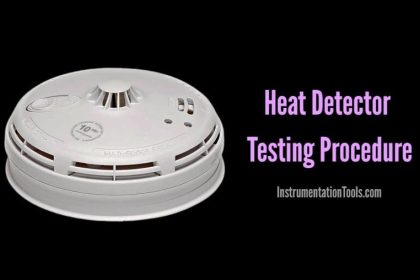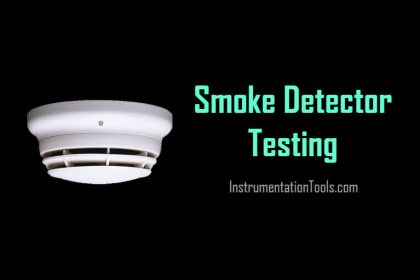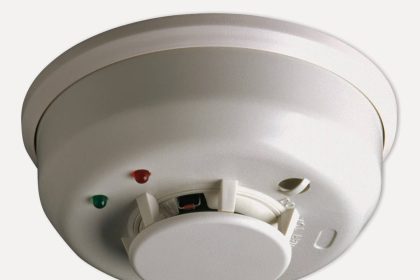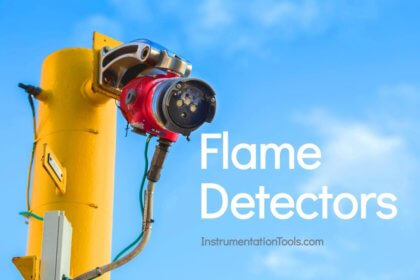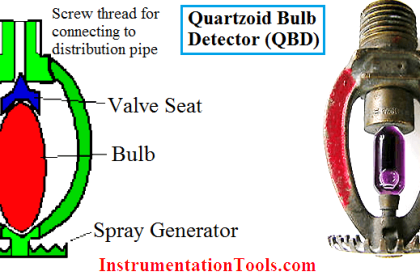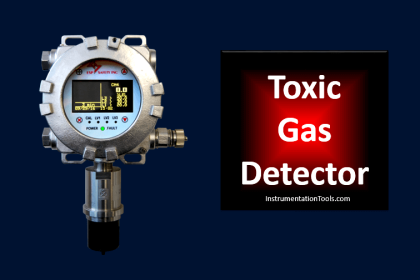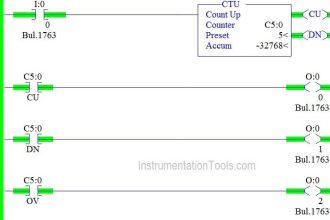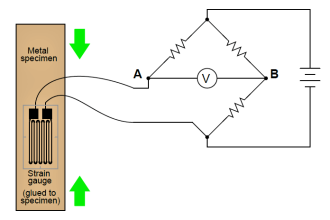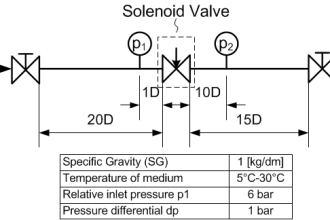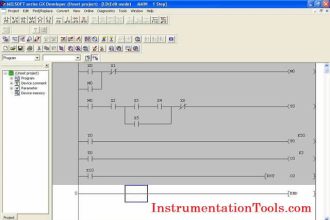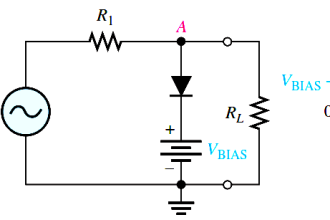This article provides the basic guidelines for the selection of fire and gas detectors like linear heat detector, rate of rise heat detector, optical smoke detector, ionization chamber smoke detector, open path gas detector, catalytic sensor type combustible gas detector, and flame detector.
Selection of Fire and Gas Detectors

Linear Heat Detector
The linear heat detectors shall sense an overheat condition at any point along its length and pinpoint its location. The heat detection system shall comprise a heat-sensing cable and a monitoring /control unit. A change in temperature along the sensing cable shall cause a relative change in resistance of the cable. This change shall be detected by the monitoring /control unit which shall signal an alarm at the preset temperature.
The sensing cable may be multicore or coaxial. One end shall be connected to the monitoring unit. The other end shall be terminated so as to create a loop that shall be continuously monitored for open and short circuit fault, and alarm condition.
Selection Criteria for Linear Heat Detector
The following are some minimum requirements applicable for linear heat detector, however, requirements vary from industry to industry.
- The outer jacket shall be made of a material that resists corrosion, chemicals, moisture, etc.
- The linear heat detector cable and monitoring system shall be suitable for operation on a nominal 24V DC supply.
- The alarm condition shall be latched at the control unit, with reset facility from the Fire and Gas panel, and locally on the control unit.
- The unit shall provide outputs for fault and alarm conditions that are compatible with the main Fire and Gas panel.
- Sensing cable and any termination units required shall be certified for use as part of a 1S circuit when installed in a hazardous area.
- Sensing cable and any termination units required shall be certified for use as part of a 1S circuit when installed in a hazardous area.
Rate of Rise Heat Detectors
A detector which response to an increase in temperature.
Selection Criteria for Heat Detectors (Rate of Rise Type)
The following are some minimum requirements applicable for the rate of rise heat detector, however, requirements vary from industry to industry.
- This type of detector shall respond to an abnormal rate of temperature rise or when a pre-set maximum temperature is reached.
- The detector shall be provided with a fixed temperature back up feature so that at a lesser rate of rise of temperature the fixed temperature element shall be operated. The alarm preset temperature shall be between 570 degrees C and 740 Deg C based on the ambient temperature at the area of installation.
- The detectors shall latch in the alarm condition until reset manually.
- The detector shall contain an LED that shall pulse to indicate power on and shall glow continuously to indicate an alarm condition.
- The detector bases shall be suitable for surface or flush mounting as required to suit the area of installation.
- The detectors shall incorporate 1acilities 10r connection and driving a remote indicator.
Optical Smoke Detectors
A detector that detects visible or invisible particles of combustion.
This type of detector shall operate by detecting the scattering or absorption of light by smoke particles.
Selection Criteria for Smoke Detector (Optical Type):
The following are some minimum requirements applicable for the optical smoke detector, however, requirements vary from industry to industry.
- The detector shall be self- contained device comprising of the light source with a matching photosensitive sensor.
- The optical chamber shall be designed for the detection of every type of visible smoke.
- The detector shall contain an LED that shall pulse to indicate power on and shall glow continuously to indicate an alarm condition.
- The visual indication shall be such that the presence or absence of the indication shall be visible from a distance of 5 meters in normal conditions of use. The failure of any indicator lamp shall not prevent the emitting of a fire alarm signal.
Ionisation Chamber Smoke Detectors
A detector that detects visible or invisible particles of combustion.
This type of detector shall operate on the principle that the electrical current flowing between electrodes in an ionization chamber is reduced when smoke particles enter the chamber.
Selection Criteria for Smoke Detector (Ionisation Chamber Type):
The following are some minimum requirements applicable for ionization chamber detector selection, however, requirements vary from industry to industry.
- The smoke detectors shall be twin-chamber ionization design incorporating low energy radiation source Am241 (Americium) elements.
- The detector shall contain an LED that shall p비se to indicate power on and shall glow continuously to indicate an alarm condition.
- The visual indication shall be such that, the presence or absence of the indication shall be visible from a distance of 5 meters in normal conditions of use. The failure of any indicator lamp shall not prevent the emitting of a fire a1arm signal.
- The detector bases shall be suitable for surface or flush mounting as required.
- The detector shall be provided with a screen to prevent the entry of insects into the sensor.
- The detectors shall incorporate facilities for connection and driving a remote indicator.
- The detectors shall latch in the alarm condition until reset manually.
- The detector shall be suitable for ceiling or wall mounting as required.
- Smoke detectors and Heat detectors shall have a common mounting base to facilitate interchangeability.
- The detector shall be provided with a screen to prevent the entry of insects into the sensor
- The detectors shall be microprocessor controlled with provision to monitor and reduce the risk of false alarms due to dust and other contaminants.
- The detectors shall incorporate facilities for connection and driving a remote indicator.
- The detectors shall latch in the alarm condition until reset manually.
Open Path Combustible Gas Detector
This type of detector shall operate on the principle of absorption of infrared radiation by gas, anywhere along the open path, detected by photoelectric means that produce electrical signals to provide alarms and indications of the concentration of gas along the path.
Selection Criteria for Open Path Type Combustible Gas Detector:
The following are some minimum requirements applicable for combustible gas detector selection, however, requirements vary from industry to industry.
- The system shall consist of a microprocessor-controlled transmitter and receiver unit with all electronic circuitry, mounting brackets, and all other accessories for the proper functioning of the detectors.
- The transmitter and receiver units shall be suitable for mounting on standard instrument posts.
- The detector system shall be provided with means to ensure reliable operation without a false alarm in all adverse ambient conditions.
- Continuous optical checks for beam blockage shall be provided. A short time blockage in the detector path shall not prevent the instrument from functioning. Blockages of greater than 10 seconds shall result in a beam -blocked warning. After 60 seconds, the instrument shall indicate a fault operation.
- The output from the unit shall be a standard 4-20 mA signal, where 4 mA shall indicate normal operation. Increasing concentration of gas shall cause the signal to increase linearly to a maximum of 20 mA. Output signals less than 4 mA should indicate “Beam Blocked ” or “Fault” at defined levels.
Catalytic Sensor Combustible Gas Detector
A Combustible Gas Detector (Catalytic Sensor Type) that senses the presence of combustible gas.
The principle of operation of the catalytic sensor shall depend upon the oxidation of flammable gas, which causes the temperature of catalytic sensing element (filament, pellistors, bead) to change as a function of the concentration of gas detected.
A bridge circuit shall be used to determine the changes in electrical resistance and the apparatus shall be calibrated to provide indications of gas concentrations
Selection Criteria for Combustible Gas Detector (Catalytic Sensor Type)
The following are some minimum requirements applicable for combustible gas detector selection, however, requirements vary from industry to industry.
- The apparatus shall be suitable for the detection of combustible gases or vapor concentrations with air from 0% to 100% LEL.
- The detector shall be a self-contained device comprising of the sensor element and any monitoring and signal conditioning electronics required to provide a linear 4-20 mA output signal to monitoring cards in the main fire and gas panel.
- The gas detector housing shall be supplied complete with a sensor unit, terminal housing, flashback arrestor, collecting cone, and any other attachments necessary to enable the detector to function correctly in the ambient conditions.
- The time of response of the detector t50 shall not be greater than 10 secs, and t90 shall not be greater than 30 secs.
- Normal variations in the ambient conditions shall not affect the performance of the detectors.
- The apparatus shall be so designed and constructed that it is not capable of itself igniting a combustible gas-air mixture.
- Detectors shall be provided with poison resistant sensors, which shall protect against poisoning caused by organic and silicone-based vapor poisons.
- Provision shall be made for testing the detectors by application of test gas. The method employed shall not necessitate the removal of dust and splash filters, gas collecting cones, or similar attachments.
- The alarm output contacts or signal outputs of a combustible gas detector shall be of a latching type requiring a deliberate manual action to reset.
Flame Detector
A detector which responds to the radiation emitted. by the flames from a fire.
Selection Criteria for Flame Detector
The following are some minimum requirements applicable for the flame detector, however, requirements vary from industry to industry.
- Flame detectors shall be combined Ultraviolet Infrared (UV /IR) type monitoring both UV and IR regions of the spectrum for the presence of fire.
- The microprocessor-based detector shall be provided with a flicker discrimination circuit to avoid false alarm caused by lightning, arc welding, and other sources of radiation. The unit shall have visual indicators to show normal operation and alarm conditions.
- The detector shall be resistant to the spurious operation caused by sunlight, artificial light, and black body radiation.
- The UV detector shall respond to light in the wavelength range of 0.185 to 0.245 microns. The IR detector shall respond to light in the wavelength range of 4.1 to 4.7 microns. The range can be different for different industries/ applications.
- The sensors shall be enclosed in a corrosion-resistant stainless steel housing. The unit shall incorporate a swivel assembly to permit final alignment in the field.
- The detectors shall have a nominal 900 cone of vision.
- The lenses of both the UV and IR detectors shall be monitored automatically for optical integrity with an output signal (Alarm). There shall be provision for automatic initiation of the optical integrity sensing system and also have facilities for its manual initiations.
Also Read:
- Fire Fighting System
- F & G System Commissioning
- Manual Call Point (MCP)
- Fire Extinguisher Quiz
- Gas Detectors Interview Questions
